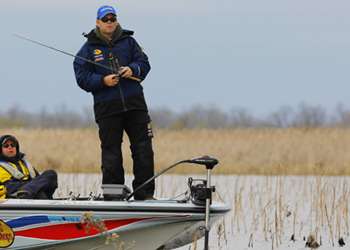
Bassmaster Elite Series pro Brian Snowden dreads the idea of running out of his most productive lure and having to run around town looking for a replacement.
However, this dilemma will probably never happen to Snowden because of his meticulous system of organizing tackle. “Being organized allows you to know what baits you have and what you are out of so you won’t have any surprises when you’re out on the water,” says the 2011 Bassmaster Classic qualifier.
“You want to spend as much time as you can fishing and the least amount of time looking for baits.” The Missouri pro keeps the same tackle regimen whether he’s at home, staying in his camper or out in the water. “I like to break my tackle down into lure types such as medium diving crankbaits or deep crankbaits or jerkbaits,” says Snowden. “That way I don’t have to carry everything in the boat all day long.”
For storing hard baits in the boat, Snowden uses Plano 3700 utility boxes. He usually keeps two of each lure in various sizes and colors in his boxes and stores his hard baits in the front of the boat. Spinnerbaits and buzzbaits are stored in canvas soft-side packs unless Snowden wants to take only 10 to 15 out on the water. In that case, he stores the blade baits in a Plano FTO spinnerbait box. Snowden keeps his weights and hooks in separate Plano 3670 boxes.
In his weight box, he carries sinkers of various weights and styles along with beads and swivels. His hook box consists of 1/0 to 5/0 extra wide gap and round bend hooks with about 10 of each size in separate compartments. Keeping his soft plastics in the original packages, Snowden separates the baits into types and stores the packs in Plano 3731 boxes.
He usually carries about six to eight colors of soft plastics during a tournament and stores about two packages of each color in his boat. Keeping track of lost baits is a key to good tackle management. “If I lose something throughout the day, I make a mental note of it and try to replace it as soon as I get off the water through my extra stock in my camper,” says Snowden, who also keeps his emptied soft plastics packages.
“At the end of the day, I have all the empty bags, and I know what I need to replace in the boat. That’s the way I keep my inventory.” Snowden’s camper becomes his lure-replenishment center while on the road. The camper contains more Plano 3700 boxes filled with hard baits and separated by lure types.
Each box contains about 10 to 20 lures of each size and color of a particular type, such as medium crankbaits or jerkbaits or topwaters. His extra soft plastics in the camper are stored in plastic tote boxes, which he labels by lure types with a label maker or Sharpie.
He carries two or three bags of each color soft plastic in the totes. Whenever he replaces anything in the boat from his camper stock, Snowden jots down the replacement items in a notebook. “We might be gone for two or three weeks, so by the end of that time I might have lost five or six crankbaits or spinnerbaits and probably five to 10 bags of worms, so it’s hard to remember all that,” says Snowden. When he returns to his home stock, Snowden refers to his notebook and replenishes his boat and camper.
His home storage consists of a pegboard loaded with soft plastics bags and hard baits in the original packages. “It actually looks like a tackle store,” he says. Once again, Snowden keeps his baits organized by filling each peg with the same lure type, such as finesse worms on one peg, creature baits on another, etc.
Editor’s Note: If you have a story idea you would like to vote on for an upcoming poll, send your idea to john@jnoutdoors.com.





